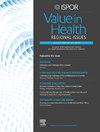Matching-Adjusted Indirect Comparison Studies in Oncology: A Scoping Review Focused on Reporting Quality
IF 1.4
Q3 HEALTH CARE SCIENCES & SERVICES
引用次数: 0
Abstract
Objectives
Matching-adjusted indirect comparisons (MAICs) can be used in case of cross-trial heterogeneity or availability of only single-arm trials. Although the National Institute for Health and Care Excellence (NICE) provides MAIC-development orientation, many still do not adhere to it. Our goal was to map MAIC oncology studies and whether NICE recommendations were observed.
Methods
We included MAIC studies comparing treatments in oncology from 2010. We searched PubMed, Embase, and the Cochrane Library up to October 1, 2024. We analyzed MAIC characteristics such as previous systematic reviews, whether the analysis was anchored or unanchored, selection of variables, and individual patient data (IPD) reporting. We adopted NICE recommendations for the assessment of MAIC studies.
Results
We included 117 MAIC studies, which often explored multiple myeloma (n = 19%) and non–small cell lung cancer (17%) more frequently. Most MAICs were unanchored (72%), with an average of 1.9 comparisons per study. MAIC studies generally reported using pseudo-IPD (69%) but did not report the source of IPD (78%). In general, MAICs did not conduct systematic reviews to select trials for inclusion (66%). The average sample size reduction, in comparison with the original trials, was 44.9%. Only 3 MAICs fulfilled all NICE recommendations. The least reported aspects were the adjustment for all effect modifiers and prognostic variables (for unanchored MAICs), evidence of effect modifier status, and distribution of weights.
Conclusions
Most MAIC models did not follow NICE recommendations. Our review highlights the importance of rigorous methodological standards and thorough reporting of MAIC studies to enhance their credibility.
肿瘤学中匹配调整的间接比较研究:聚焦于报告质量的范围综述
目的匹配调整间接比较(MAICs)可用于跨试验异质性或只有单组试验可用性的情况。虽然国家健康和护理卓越研究所(NICE)提供了maic发展方向,但许多人仍然不坚持。我们的目标是绘制MAIC肿瘤学研究的图谱,以及NICE的建议是否得到了遵守。方法我们纳入了2010年以来比较肿瘤治疗的MAIC研究。我们检索了PubMed, Embase和Cochrane Library,截止到2024年10月1日。我们分析了MAIC特征,如以前的系统评价,分析是否锚定或非锚定,变量的选择和个体患者数据(IPD)报告。我们采用NICE的建议来评估MAIC研究。我们纳入了117项MAIC研究,其中多发性骨髓瘤(n = 19%)和非小细胞肺癌(17%)的发生率更高。大多数MAICs是非锚定的(72%),每项研究平均有1.9个比较。MAIC研究通常报告使用伪IPD(69%),但没有报告IPD的来源(78%)。一般来说,MAICs没有进行系统评价来选择纳入的试验(66%)。与原始试验相比,平均样本量减少了44.9%。只有3个MAICs符合NICE的所有建议。报道最少的方面是所有效果调节剂和预后变量的调整(对于未锚定的MAICs),效果调节剂状态的证据和权重分布。结论大多数MAIC模型没有遵循NICE的建议。我们的回顾强调了严格的方法标准和全面报告MAIC研究以提高其可信度的重要性。
本文章由计算机程序翻译,如有差异,请以英文原文为准。
求助全文
约1分钟内获得全文
求助全文
来源期刊

Value in health regional issues
Pharmacology, Toxicology and Pharmaceutics-Pharmacology, Toxicology and Pharmaceutics (miscellaneous)
CiteScore
2.60
自引率
5.00%
发文量
127
 求助内容:
求助内容: 应助结果提醒方式:
应助结果提醒方式:


